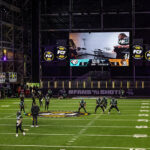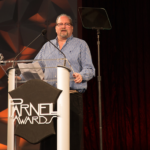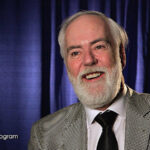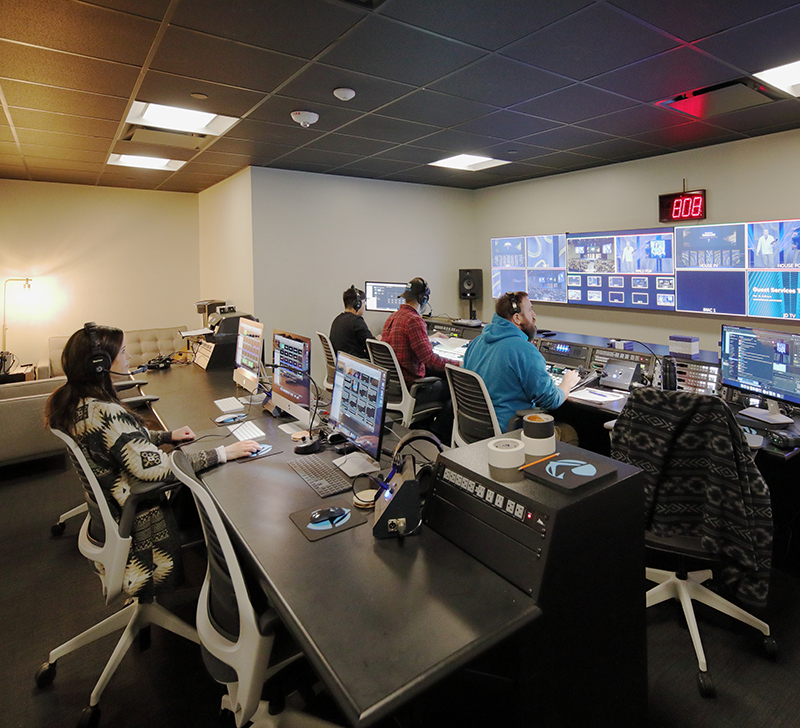
The last couple decades have seen a shift in how churches experiencing significant growth in attendance handle the influx of new people. At one time, the only answer was to expand their facility or move to a new location; however, it’s now more common to turn to the multi-site church model to handle the growth.
The Summit Church of Durham, NC is one such church, and it recently opened a new campus in the Capital Hills area of Raleigh as their ninth location in central North Carolina. Unlike the typical multi-site expansion, however, the Capital Hills campus was designed to become the primary broadcast location for the church, moving this operation from their Brier Creek facility in Durham. Unlike when the Brier Creek campus was created over a decade ago, The Summit Church had the foreknowledge that video and audio broadcast to other campuses as well as the internet would be a critical function of this campus, and thus could plan on designing the facility for this critical function of any multi-site church.
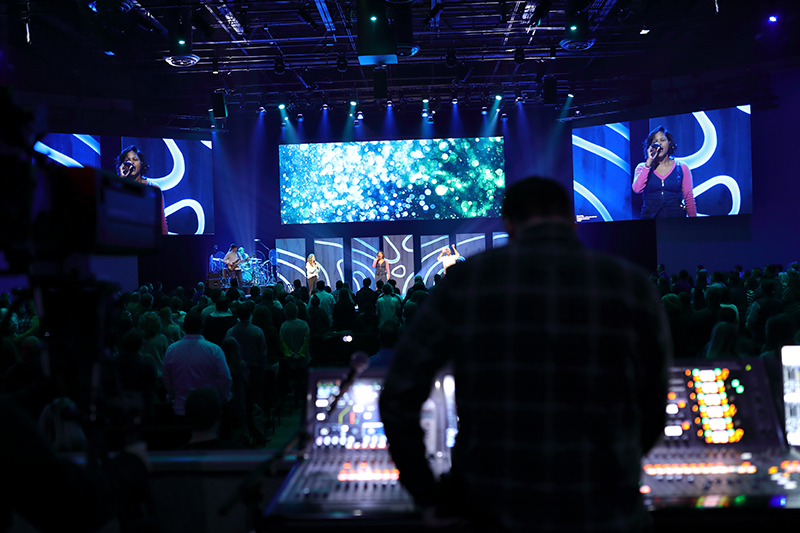
Broadcast a Priority
“We knew we needed to improve broadcast capabilities,” says Justin Manny, production pastor at The Summit Church. “We wanted to capture a better image and create a better experience for the other campuses and those watching the service via online streaming. Brier Creek had been built over time — systems built on top of each other in a piecemeal fashion. It wasn’t designed from the ground up to provide the level of support that is now needed. Building this new facility intentionally to support our broadcast needs has given us the opportunity to design our systems with the quality level desired in mind.”
Summit had started out utilizing an AVL design firm they had worked with in the past; however, as the prior project concluded they were not satisfied with the customer service delivered by that firm. Summit’s production staff were introduced to the CSD Group out of the Fort Wayne, IN, area through mutual friends, and as they got to know each other, it became apparent that working with CSD might provide better results. Summit moved the new project over to CSD.
“The new Capital Hills building was already in the middle of the construction process when we came on board,” says David McCauley, principle consultant at CSD Group, and lead designer for the project. “So, we had to dive in and get up to speed quickly. Infrastructure was the biggest challenge. There were certain things we were able to influence; other things were already in the ‘it is what it is’ stage. The height of the room was such that HVAC infrastructure would interact with what we wanted to do. Concrete was getting ready to be poured and conduit was already run, so we needed to work with some of the existing AVL design ideas.”
Summit’s approach to being a multi-site church mirrors in concept what other multi-site churches are doing: all aspects of the service, such as a worship time through music, announcements, etc. are handled locally by each campus except for the sermon. The sermon is streamed live from the broadcasting campus to the other campuses, while the 10:45 a.m. service on Sunday is also featured on the Internet via Facebook and Vimeo’s livestream.com. Therefore, quality video capture is critical to the church. Summit had just launched their first campus that was a totally new construction in Apex, NC, while the planning for Capital Hills was underway, Summit’s production staff was able to carry a few lessons forward from the Apex project to Capital Hills.
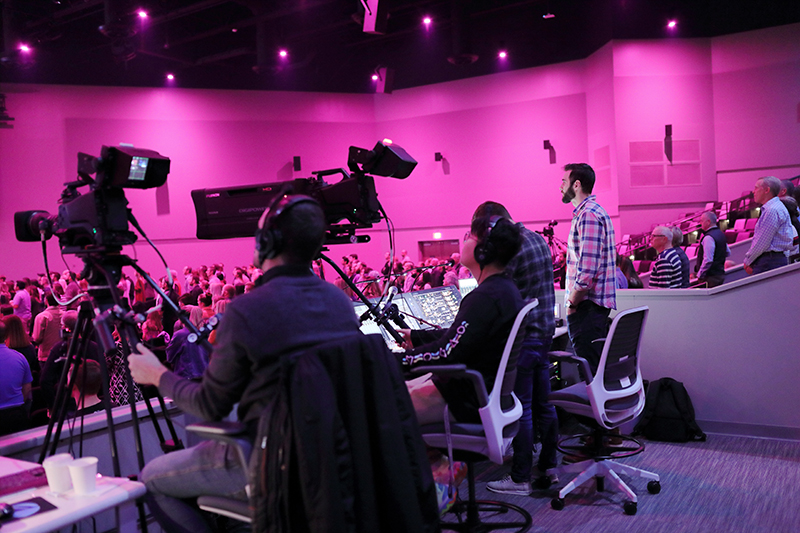
Video Installation
“One of the lessons we learned in building our Apex facility was in our first use of LED video walls,” says Manny. “The video wall we went with was considered good at the time, but the 6mm pixel pitch was too coarse for use as a backdrop to the stage. And the cameras we used had a deeper depth of field. That, combined with the less dense pixel pitch, gave us really poor results on video. We have a bad Moiré effect when the walls are in a tight camera shot. And, the panel size available from that manufacturer was square, which made for some odd aspect ratios for the space we wanted to allocate to screens.”
“So, for Capital Hills, we went with Vanguard P4 Rhodium LED Panels with a 3.9mm pixel pitch for our video walls,” Manny states. Three NovaStar video processing units control the three LED video walls. “We also chose to keep them out of the main camera shots used for preaching. Even though they have a smaller pixel pitch, it would be simpler to just keep them out of the close-up camera shots and avoid color temperature differences shifting the colors of the screen when used as I-Mag shots.”
“Reliability and aspect ratio were also a consideration,” adds McCauley. “Vanguard has 16×9 aspect ratio panels, so everything you build out of them is easy to make 16×9. Their rigging capabilities are great, and they looked really good on camera. We did some testing at the CSD office and flew Justin out to make sure they would meet expectations.”
Another reason for going with a physical backdrop as opposed to video walls was staffing. “We have one graphic designer at Summit who supports all our campuses,” says Manny. “Using the video walls as a backdrop would mean putting more work on their plate, having to create background graphics each week for the service. Going with a physical backdrop would let us still achieve branding without the extra workload. And then we only have to be concerned about how the LED video walls translates on camera for the wide camera shots.”
For video cameras, CSD recommended Sony. “We just love Sony stuff,” says McCauley. “The black levels on their cameras are great, they are industry standard, and they do a great job at keeping the colors true. They’ve also become more cost effective.” Four HXCFB80HN studio cameras were installed, along with CCUs for shading, and one of the two center-line cameras is outfitted with a Fujinon studio box lens for the tight follow shot from the FOH booth.
The Summit Church had already standardized around the Ross Carbonite for switching, and they continued with Ross for Capital Hills. A Carbonite Black Plus 2 M/E with two control panels (one that can handle both M/Es, and one that can handle just one of the M/Es) was installed. “We switch two separate streams,” says Manny. “One for I-Mag, and one for streaming. With these two panels, one person could switch both or we can have two different people each responsible for switching one of the two video feeds.”
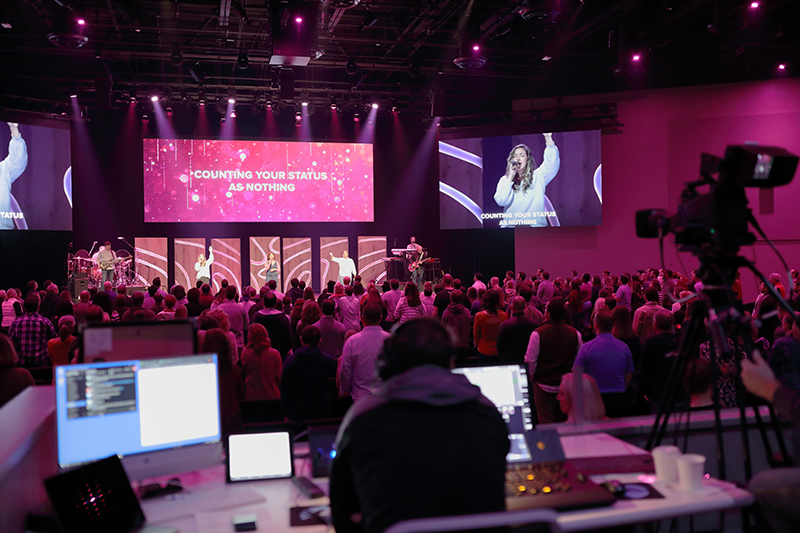
Streaming
Summit has developed a system of streaming to their campuses that works well for them and incorporates several layers of redundancy. The first service of the weekend is at 4 p.m. on Saturday, and four campuses have Saturday services at this time. Living As One is Summit’s primary streaming service, utilizing hardware encoders and decoders, and is point-to-point via the Internet to the campuses. Additionally, Livestream (Vimeo’s corporate streaming service) is used as a secondary streaming system through private shared link to the campuses in case a problem arises with the Living As One service. Should the connection to Living As One go down, campuses will have Livestream playing on a Mac ready to be switched two as soon as a problem arises.
The broadcasting campus (either Capital Hills or Brier Creek) also records the service to SSD drives on nine Blackmagic Design Hyperdeck Studios, producing one drive for each of the campus locations. As soon as the preaching portion of the service is over, the SSDs are ejected and runners from those campuses that have Saturday services immediately take their campus’ SSD and drive to their campus location. Typically, the campuses receive their drive during the second song of opening worship, giving them a high-quality recording to play back if there isn’t live preaching planned for one of the services, or if Internet issues prevent a campus from receiving the sermon live from the broadcasting campus. Campuses only having a Sunday service have more flexibility in picking up their drive Saturday evening.
The greatest vulnerability for the church is during the first service, and the campus pastor at each campus location has a “sermon in their desk drawer” ready to go, should all else fail. All campuses receiving their sermon from the broadcasting campus delay the start of their service for two minutes to help ensure that the broadcast campus is into the sermon already by the time the receiving campuses reach the preaching point of their service. And, in case one of the receiving campuses is running ahead of the broadcasting campus, the services are structured so that someone is on stage right before the sermon and can “stretch” that portion of the service if needed. A message is flashed onto the rear confidence monitor via ProPresenter that they need to stretch, and they do so until an “all clear” message is put up. Generally, campuses try to have a two-minute buffer of sermon video queued up before starting playback so that, should something go wrong, they have those two minutes to alert the local campus pastor that they need to get on stage.
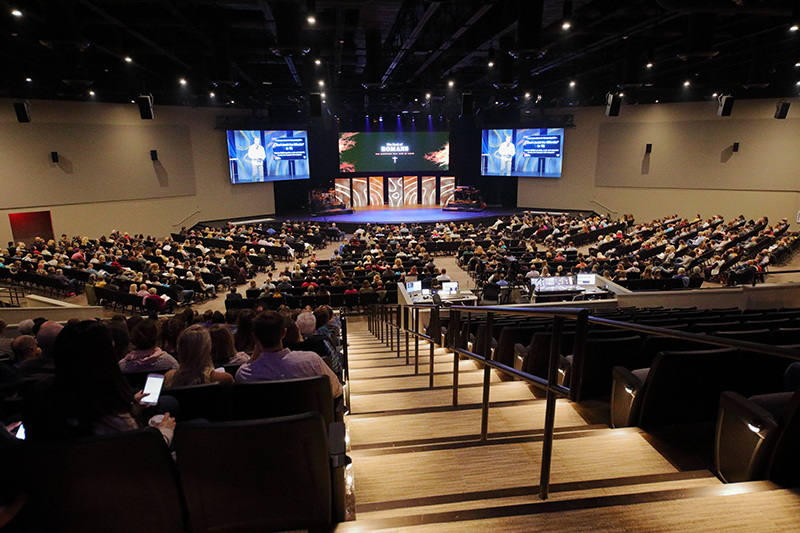
Lighting
For lighting, Summit has also standardized on their control solution. “We like the MA Lighting dot2 console as it has been easy for volunteers to learn,” says Manny. “And constancy in our control solutions means that our leaders only have to teach one thing to the volunteers. They just have to learn what fixtures are available to work with at each campus.”
For lighting, Chauvet Professional and Elation fixtures make up the stage lighting. “The initial design had every wash fixture being a mover,” says Manny, “but that was just too much. We went with a series of static Chauvet Professional Ovation F-915FC and COLORdash Par-Quad 7 that wash the stage, plus ten Chauvet Maverick MK2 moving head washes to strategically light areas that the static fixtures don’t hit. We have a ton of Elation SIXBAR 1000 IP lights to wash the haze with uplighting to create ‘airiness’. For key lighting, Chauvet Professional Ovation E-160WW LED ellipsoidals cover most of the stage, with four Chauvet Professional Maverick MK1 moving-head Spots providing some additional aimable spotlighting capabilities. We have an additional eight Maverick MK1s on stage truss and floor for beam effects.”
“We used a lot of Chauvet because, at this time, they are the best bang for your buck,” states McCauley. “They have really great products that fit the need, and we have really good results with these fixtures.
“We like to create a look and a feel per song,” Manny adds, “and then add depth and texture with lights through the haze. Most of our stuff is calm and intentional. Our MDG ATMe hazer is great — we like the way the haze hangs; it doesn’t feel smoky. We don’t have to run it all the time to keep haze throughout the worship segment.”
One thing that’s new with this campus is making use of uplighting for the apron. “We were able to add a trough to the front of the stage to house Elation DTW 392 LED Bars for use as uplighting, particularly for the sermon part of the service,” says McCauley. “But you have to be careful and keep it natural. If you do it wrong, everything feels upside down — the shadows start coming from the wrong direction. Used correctly, it enables you to keep your main front lights at a higher down angle, because you’re using your uplights to fill in and eliminate ‘raccoon eyes,’ etc. And it enables us to keep the lighting on the faces nice and consistent for video. For worship, it lets us reduce the amount of key lighting that would wash out the stage color wash because we can augment that key light with the uplighting.”
The End Result
“Our experience working with CSD was really good,” says Manny. “They exceeded my expectations. The value of what we got with CSD is way higher than what happened when we built our Apex facility. CSD was brought into the process late and had to work within some constraints, which is a challenging position to be in. Their install team was great. I’m excited to see what they can do when they are brought in from day one with a design process.”
The Summit Church’s Broadcast Campus
Gear
Video:
- 320 Vanguard P4 Rhodium LED Panels for main video display
- 3 NovaStar video processing units
- 4 Sony HXCFB80HN studio cameras
- 4 Sony HXCUFB80N camera control units
- 4 Sony RCP1500 remote control panels
- 1 Fujinon XA55X95BESM5LLO lens
- 1 Ross Carbonite Black Plus 2 M/E live production switcher
Lighting:
- 12 Chauvet Maverick MK1 Spots
- 10 Chauvet Maverick MK2 Washes
- 6 Chauvet Ovation F-915FC 18
- 9 Chauvet Ovation P-56WW warm white pars
- 15 Elation DTW 392 LED bars
- 20 Elation SIXBAR 1000 IP LED bars
- 1 MDG ATMe haze generator
Spotlight System:
- 29 Chauvet Ovation E-160WW LED ellipsoidals
- 26 Chauvet Ovation F-915C full color LED Fresnels
House Lighting:
- 41 Chroma-Q Inspire XT RGBW LED DMX fixtures
- 27 Chroma-Q Inspire Wide RGBW LED DMX fixtures
Control:
- 1 grandMA dot2 lighting console
- 2 Chauvet NetX II
Rigging:
- 10 Tyler Truss Centerline truss sections
